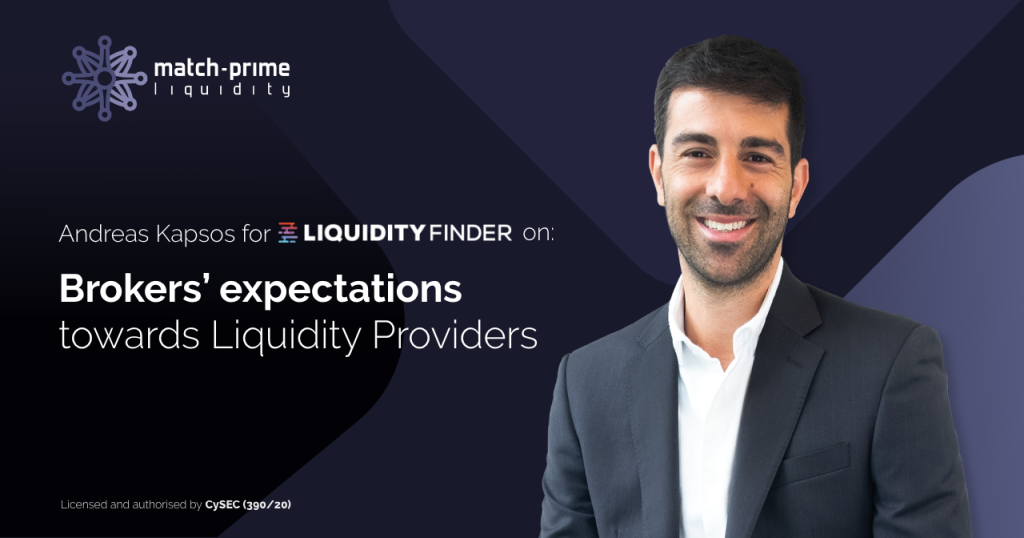In an ever-evolving market, Brokers’ requirements for Liquidity Providers are constantly changing. What features do customers pay attention to most often? How has this approach changed in recent years and what are the prospects for the future? Our CEO Andreas Kapsos shared his thoughts with LiquidityFinder.

From your experience working with Forex Brokers, what are the main criteria for choosing a liquidity provider, and how long does the due diligence process usually take?
From our experience as a liquidity provider, it appears that for many brokers, the first criterion when choosing an LP is their reputation and the industry relationships they have built. We also see how advantageous it is for brokers that, at Match-Prime, they always have contact with decision-makers. I personally take great care to regularly communicate with clients and ensure they know they can reach out to me directly in case of any issues. We have a mutual understanding that the decisions we make, especially when there’s a conflict of interest, can have a huge impact on the success or failure of the broker’s business. Therefore, trust cannot be underestimated in the B2B industry. Of course, liquidity quality, system reliability, offer and customisation capabilities to meet brokers’ needs and align with their business objectives are fundamental, but there is already a high standard maintained in the liquidity provider space. That’s why, at Match-Prime, we utilise the advantages of our technology to demonstrate to brokers how we can address the issues they face daily, such as NOP limits, large volume orders, or end-of-day reports if we are in different time zones.
But before we delve into the details of our offer, we know that many clients first check us in the industry by seeking opinions from our partners to independently verify the quality of our services. From the LP’s perspective, the due diligence process doesn’t have to be lengthy. We are prepared for clients conducting background checks, and we have appropriate procedures in place.
How many liquidity providers do brokers typically work with?
It is difficult to provide a specific number as the number of liquidity providers a broker works with can vary depending on their business model, target market, client base, or the regulations they are subject to. It seems that currently, all well-established brokers understand the need to diversify their liquidity sources. Relying on a single liquidity provider can expose brokers to potential risks such as technical issues or changes in the LP’s business operations, which can disrupt liquidity supply. Therefore, even for the sake of business continuity, a backup in the form of a second LP is necessary, giving the flexibility to switch Liquidity providers within minutes and continue servicing clients immediately.
Additionally, brokers usually aim to provide competitive pricing to their clients, and by partnering with multiple liquidity providers, they can tap into a larger liquidity pool and obtain better pricing, tighter spreads, and improved trade execution. Another reason to have multiple LPs is to gain access to a wider range of instruments like exotic currency pairs or less popular asset classes, which can be provided by specialised LPs from different jurisdictions This enables brokers to offer a more comprehensive product range and attract a wider customer base. Furthermore, there are differences in offerings and technological capabilities among LPs, such as NOP limit levels or the ability to accept large-volume orders. Therefore, from a business efficiency and security standpoint, it is better to hedge with several liquidity providers.
Do brokers favour working with listed liquidity providers for reasons of transparency?
Some brokers probably do, but in our experience as a liquidity provider, being listed is not the sole determining factor, nor the most important one. There are many factors beyond formal requirements that have a significant impact on broker-LP cooperation and need to be considered. Things like liquidity depth and diverse sources, in-house technology that can be constantly adapted to market changes, reputation, the ability to reach a compromise on disputed issues, or even cost efficiency carry significant weight in the decision-making process. Ultimately, the choice of liquidity provider depends on the broker’s assessment of various factors, including the reliability, quality, and compatibility of the liquidity provider’s offerings with the broker’s trading environment and client base.
Do you expect to see consolidation in the liquidity provider space over the next few years?
Given the dynamic nature of the forex market and the increasing regulatory scrutiny, I think we might expect some degree of consolidation in the liquidity provider space. Stricter regulations and compliance requirements may make it challenging for some liquidity providers, particularly smaller ones with limited resources, to meet the new demands, significantly affecting their competitiveness. Additionally, as the market continues to evolve, customer expectations regarding quality and liquidity depth are increasing. Also, the regulators prioritise investor protection, having the best execution at the top of their agenda. Established liquidity providers have a competitive advantage in meeting these demands as they can offer competitive pricing and access to diverse liquidity sources due to their strong relationships with multiple institutions, proven reliability and experience Also, to keep up with the evolving technological landscape, liquidity providers need to invest in sophisticated trading systems and infrastructure, such as algorithmic trading, high-frequency trading, and the use of artificial intelligence. Smaller liquidity providers may struggle to keep pace with these technological advancements. Therefore, it can be challenging for smaller or less established liquidity providers to meet changing standards, potentially leading to consolidation as larger and more robust players gain a competitive advantage. However, the entry of new players and technological innovations can also disrupt the market dynamics.
Contact us if you want to discuss how our liquidity can help you develop your business.

